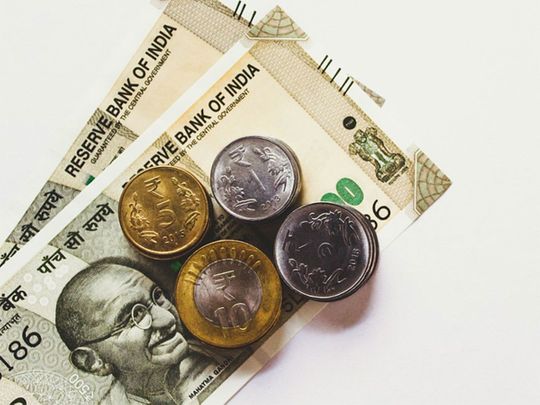
What’s hurting the rupee
Concerns on India’s slowing economic growth
Massive pull out of foreign portfolio investments
Pessimism over key sectors such as manufacturing and financial services
Fears of global slowdown triggered by US – China trade war
Unpopular capital gains tax on foreign portfolio investors
The Indian rupee on Monday plunged to a near eight-month low of 72.03 (Dh19.60) a dollar, dropping 22 paise against the greenback as the finance minister’s weekend booster package for the economy and market could not arrest the currency’s slide.
Sell off on equity markets and incessant foreign fund outflows in recent weeks continued to weigh on the currency.
Policy uncertainty on the local front and worries over a sustained economic slowdown are keeping the local indices and the rupee under pressure.
In October last year, the rupee had breached $74 (Dh20.20), when massive pull out of funds by foreign portfolio investors took its toll on the currency.
The rising rhetoric on trade war between the US and China and concerns growth rates of the Indian economy and some policy changes introduced in the recent budget have seen foreign investors turning net sellers on Indian equity market in recent weeks.
“The hike in the surcharge on income tax on earnings of “foreign portfolio investors (FPIs)” was a matter of worry,” said Adeeb Ahamad, Managing Director at Lulu Financial Group. “On account of this, FPIs pulled out more than 30 billion rupees from the Indian capital markets during the month,” said Ahmad.
Stimulus falls short
Analysts fear that New Delhi still doesn’t have a cohesive strategy to reverse the economic slowdown and boost investor confidence.
Finance Minister Nirmala Sitharaman announced a stimulus package on Friday. The key highlight was the rollback of a tax surcharge on overseas investors that the government had imposed in July’s budget. Additionally, the government allowed concessions on vehicle purchases and hastened an infusion of an already announced 700 billion rupees ($9.8 billion) of capital in public sector banks.
Equity market responded positively to these concessions with key market index Sensex gaining 792.96 points on Monday to close at 37,494.12. Analysts fear these gains are likely to taper off in the coming weeks.
“Indian equities were due for a rebound after a steep decline and Friday’s announcement provided that trigger, but the global cues aren’t conducive,” said Deepak Jasani, head of retail research at HDFC Securities. “I’m not sure if these steps will make material impact on stocks beyond a few weeks.”
The slowing down of domestic demand is reflected in significant moderation in core consumer price (CPI) inflation and domestic economic activity has shown signs of further weakening, Reserve Bank of India governor Shaktikanta Das stated in the last monetary policy meeting.
Market players are not very optimistic on the effectiveness of the latest stimulus package. Billionaire investor Rakesh Jhunjhunwala told ET Now, an Indian television channel on Monday that he has never seen such pessimism in the market. “It looks overdone. But I believe it is way too much to expect the market to rebound immediately,” he said.
NRIs on wait and watch mode
Dubai: The recent sharp fall in the exchange rate of rupee against the UAE dirham has seen a moderate jump in remittance volumes with many non-resident Indians (NRIs) expecting a further decline of rupee.
Adeeb Ahamad, Managing Director at Lulu Financial Group, reckons the pressure on the rupee is unlikely to abate. “We feel the rupee can extend its weakness to 72.80… before reversing the trend to some extent.”
That is in a best-case scenario. But if the “trade war and Brexit concerns are still lingering and the situation gets worse, the rupee can test 73.50 in another month.”
From a remittance standpoint, an increase in remittance transactions to India could be expected. Going by industry trends, customers from the white - collar segment are known to accelerate their remittance transactions at such times in order to gain good value on their money transfers according to Sudhesh Giriyan, CEO, Xpress Money.
“The Indian rupee today has weakened to the level of 72.14 against the dollar, the lowest it has been this year. The reasons that could be attributed to the weakening is a strong US dollar, escalating trade tensions between US and China and rising crude oil prices. The rupee has been further impacted by the weakening of the Chinese currency yuan that has cast a shadow on the economic outlook,” said Giriyan.








